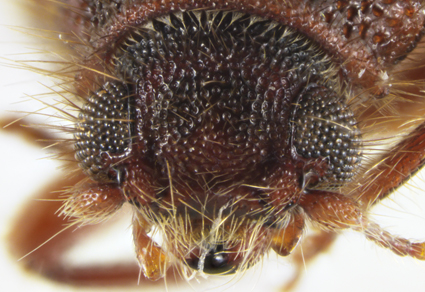Abstract
Apparent superficial non-homogeneity of species assigned to the genera Apopylus Kolibáč, Fallopylus Opitz and Pylus Newman prompted reassessment of genus characters and species assignment of those genera plus Parapylus Blackburn and Pseudopylus Opitz, all of which were defined by Opitz (2015) primarily on the number of tibial spurs. Morphological investigation resulted in discovery of suites of correlating character state pairs providing more robust evidence for monophyly of the genera under study than tibial spurs alone. On this basis, genus definitions were revised, and species assigned accordingly to the newly defined genera. Taxonomic changes proposed include synonymy of Fallopylus Opitz, 2012 new synonym and Pseudopylus Opitz, 2012 new synonym with Pylus Newman, 1841, plus the following new combinations: Apopylus astrictus (Opitz, 2015) new combination (transferred from Fallopylus); Apopylus creperus (Opitz, 2015) new combination (transferred from Fallopylus); Apopylus leptofustus (Opitz, 2015) new combination (transferred from Fallopylus); Apopylus redactus (Opitz, 2015) new combination (transferred from Fallopylus); Pylus apterus (Opitz, 2015) new combination (transferred from Pseudopylus); Pylus cavus (Opitz, 2015) new combination (transferred from Fallopylus); Pylus cruslumus (Opitz, 2015) new combination (transferred from Apopylus); Pylus kolibaci (Opitz, 2015) new combination (transferred from Apopylus); Pylus nactus (Opitz, 2015) new combination (transferred from Apopylus). Pylus okei Elston, 1929 and Pylus pallipes Macleay, 1872 are returned to their original combinations from Apopylus and Fallopylus respectively. In addition to evidence for the monophyly of genera being based on more robust lines of morphological evidence, the newly defined genera are also more obviously homogenous, with superficially similar looking insects now grouped together.
References
- Bartlett, J.S. (2013) A revised taxonomy for Australian Teneropsis Chapin and Cregya LeConte (Coleoptera: Cleridae: Korynetinae). Memoirs of the Queensland Museum—Nature, 58, 411–420. https://doi.org/10.17082/j.2204-1478.58.2013.2013-18
- Bartlett, J.S. (2021) A preliminary suprageneric classification for Clerinae (Coleoptera: Cleridae) based on molecular and morphological evidence, including a review of tegminal terminology. Annales Zoologici, Warszawa, 71 (4), 737–766. https://doi.org/10.3161/00034541ANZ2021.71.4.003
- Blackburn, T. (1891) Further notes on Australian Coleoptera, with descriptions of new genera and species. Part X. Transactions and Proceedings of the Royal Society of South Australia, 14 (2), 292–345.
- Darwin, C. (1871) On the Origin of Species by Means of Natural Selection, or the Preservation of Favoured Races in the Struggle for Life. Fifth Edition, with Additions and Corrections. D. Appleton and Company, New York. Available from: https://www.biodiversitylibrary.org/item/71804#page/382/mode/1up (accessed 15 January 2024)
- Elston, A.H. (1929) Australian Coleoptera. Part VI. Transactions and Proceedings of the Royal Society of South Australia, 53, 347–352.
- Gorham, H.S. (1878) Descriptions of new genera and species of Cleridae, with notes on the genera and corrections of synonymy. Transactions of the Entomological Society of London, 1878 (2), 153–167. https://doi.org/10.1111/j.1365-2311.1878.tb00871.x
- ICZN (1999) International Code of Zoological Nomenclature. Fourth Edition. International Trust for Zoological Nomenclature, London, 306 pp.
- Kolibáč, J. (2003) A revision of Australian genera of Korynetinae (Coleoptera, Cleridae). Entomologica Basiliensia, 25, 41–97.
- Kolibáč, J. & Huang, D. (2016) The oldest known clerid fossils from the Middle Jurassic of China, with a review of Cleridae systematics (Coleoptera). Systematic Entomology, 41, 808–823. https://doi.org/10.1111/syen.12192
- Macleay, W.J. (1872) Notes on a collection of insects from Gayndah (second paper). Transactions of the Entomological Society of New South Wales, 2, 239–370.
- Opitz, W. (2010) Classification, evolution, and subfamily composition of the Cleridae and generic content of the subfamilies (Coleoptera: Cleroidea). Entomologica Basiliensia et Collectionis Frey, 32, 31–128.
- Opitz, W. (2012) Classification, natural history, and evolution of Tarsosteninae (Coleoptera: Cleridae)—Part I: Generic composition of the subfamily and key and phylogeny of genera. Psyche, 2012, 1–35. https://doi.org/10.1155/2012/752402
- Opitz, W. (2015) Classification, natural history, and evolution of Tarsosteninae (Coleoptera: Cleroidea: Cleridae) Part II: Taxonomy of the Pylus complex of Australia and Tasmania. Acta Musei Moraviae, Scientiae biologica, Brno, 100 (2), 254–279.
- Newman, E. (1841) Entomological notes (continued). The Entomologist, 1 (3), 33–37. https://doi.org/10.5962/bhl.part.9070
- Newman, E. (1842) List of insects collected at Port Phillip, South Australia, by Edmund Thomas Higgins, Esq. The Entomologist, 1 (23), 361–369.
- Solervicens, J.A. (2007) Cladistic analysis of the species of Calendyma Lacordaire (1857) and Epiclines Chevrolat (1838) (Coleoptera: Cleridae: Clerinae). Zootaxa, 1497 (1), 57–68. https://doi.org/10.11646/zootaxa.1497.1.6
- Spinola, M. (1841) Monographie des Térédiles. Revue Zoologique par La Societé Cuvierienne, 4, 70–76.
- Spinola, M. (1844) Essai monographique sur les Clérites. Insectes Coléoptères. Vol. I. Imprimerie de fréres Ponthenier, Genes, IX + 386 pp.


